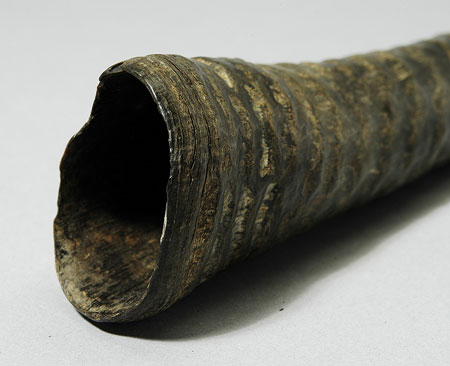Accession Number:
1917.25.73
Country:
Sudan
Region:
[Southern Sudan]
Cultural Group:
Nuer
Date Made:
By 1917
Materials:
Antelope Horn Animal
Process:
Carved , Hollowed , Perforated
Dimensions:
L = 764, mouthpiece diam = 40 x 21.7; embouchure diam = 35 x 21.7; bell diam = 51.5 x 37.8, bell opening int. = 48 x 37 mm [RTS 7/9/2005].
Weight:
234.4 g
Other Owners:
Robert Grenville Gayer-Anderson, probably collected in the period immediately before World War I (1909-1914) [RTS 1/6/2004].
Field Collector:
Robert Grenville Gayer-Anderson
PRM Source:
Robert Grenville Gayer-Anderson
Acquired:
Donated 1917
Collected Date:
By 1917
Description:
Long side-blown trumpet carved from a single piece of hollowed-out opaque greenish grey oryx horn (Pantone 417C), that has probably been straightened and polished.
This has a solid proximal end with circular section, and a narrow body with slight curvature that gradually tapers out towards an oval, thin-walled bell mouth with sharp lip.
The surface of the horn is covered with a natural ribbing around the lower body that becomes more pronounced towards the distal end.
About one third the way down the body there is a raised mouthpiece with an oval embouchure cut into it.
The lip of this mouthpiece has dark marks surrounding it, and may have been formed by applying heat to the surface of the horn.
The embouchure leads into the body of the trumpet, which has a narrow wind way that extends for an unknown distance towards the proximal end.
The trumpet is nearly complete; the tip has broken off the end and there are surface chips missing from this area, as well as from the lip of the embouchure and edge of the bell.
It has a weight of 234.4 grams and a length of 764 mm; the mouthpiece has a diameter of 40 by 21.7 mm, and the embouchure measures 35 by 19 mm; the bell measures 51.5 by 37.8 mm across the exterior, with an internal opening of 48 by 37 mm across.
Collected by Robert Grenville Gayer-Anderson, probably between 1909 and 1914, in the period immediately before World War I, somewhere along the Sudanese/Ethiopian border. It probably came from one of the eastern Nuer groups close to the now Ethiopian border, such as the Eastern Jikany.
Rachael Sparks 17/9/2005.
Collected by Robert Grenville Gayer-Anderson, probably between 1909 and 1914, in the period immediately before World War I, somewhere along the Sudanese/Ethiopian border. It probably came from one of the eastern Nuer groups close to the now Ethiopian border, such as the Eastern Jikany.
Rachael Sparks 17/9/2005.
Primary Documentation:
Accession Book Entry
[VI, p.
54] - 1917 [pencil insert] 25 [end insert]
MAJOR R.G.
GAYER-ANDERSON
, R.A.M.C.
The Lodge, Old Marston, Oxon [pencil insert, p.
56] 73 [end insert] - Side-blast trumpet of oryx horn, Nuer, Sudan-Abyssinian frontier.
Additional accession book entry [page opposite 54] - A gift to the Pitt Rivers Museum in memory of Major R.G. Gayer-Anderson, Pasha, his twin brother Colonel J.G. Gayer-Anderson, C.M.G., D.S.O. [page opposite 56] 1917.25.73 Number given HLR, L. 77 cms.
Card Catalogue Entry - EAST SUDAN, ABYSSINIAN Side-blast trumpet of oryx horn. Largish embouchure raised by heat. (JM; There is no further information on the tribes catalogue card, RTS 23/7/2004].
Pitt Rivers Museum label - AFRICA, Sudan. NUER tribe. Side-blown trumpet of oryx horn. d.d. R.G. Gayer-Anderson, 1917.25.73 [plastic coated label, tied to object; RTS 7/9/2005].
Written on object - Oryx-horn trumpet, NUER SUDAN-ABYSSINIAN frontier. Pres. by Major R.G. Gayer-Anderson, 1917 [RTS 7/9/2005].
Related Documents File - Two letters dated 30/03/1917 and 13/04/1917 from the donor to Henry Balfour regarding the donation of the collection to the museum. These indicate that the material was collected by Robert Gayer-Anderson himself, chiefly from the areas of Nuba, Kordofan and Bahr el Ghazal during 5 years he spent in the Sudan, and that they were given to the museum as an unconditional gift. The note in the accession book calling this gift 'in memory of' R.G. Gayer-Anderson is therefore somewhat enigmatic, as both Robert and his twin brother (Thomas G., not J.G.) were alive at the time of the transfer [RTS 5/12/2003].
Additional accession book entry [page opposite 54] - A gift to the Pitt Rivers Museum in memory of Major R.G. Gayer-Anderson, Pasha, his twin brother Colonel J.G. Gayer-Anderson, C.M.G., D.S.O. [page opposite 56] 1917.25.73 Number given HLR, L. 77 cms.
Card Catalogue Entry - EAST SUDAN, ABYSSINIAN Side-blast trumpet of oryx horn. Largish embouchure raised by heat. (JM; There is no further information on the tribes catalogue card, RTS 23/7/2004].
Pitt Rivers Museum label - AFRICA, Sudan. NUER tribe. Side-blown trumpet of oryx horn. d.d. R.G. Gayer-Anderson, 1917.25.73 [plastic coated label, tied to object; RTS 7/9/2005].
Written on object - Oryx-horn trumpet, NUER SUDAN-ABYSSINIAN frontier. Pres. by Major R.G. Gayer-Anderson, 1917 [RTS 7/9/2005].
Related Documents File - Two letters dated 30/03/1917 and 13/04/1917 from the donor to Henry Balfour regarding the donation of the collection to the museum. These indicate that the material was collected by Robert Gayer-Anderson himself, chiefly from the areas of Nuba, Kordofan and Bahr el Ghazal during 5 years he spent in the Sudan, and that they were given to the museum as an unconditional gift. The note in the accession book calling this gift 'in memory of' R.G. Gayer-Anderson is therefore somewhat enigmatic, as both Robert and his twin brother (Thomas G., not J.G.) were alive at the time of the transfer [RTS 5/12/2003].





